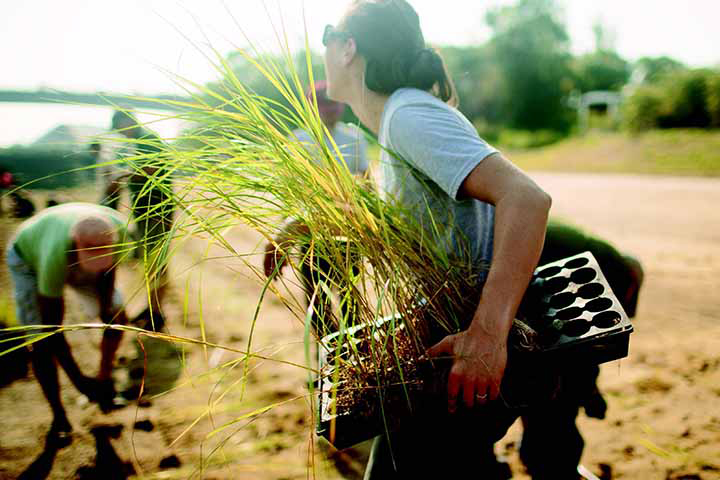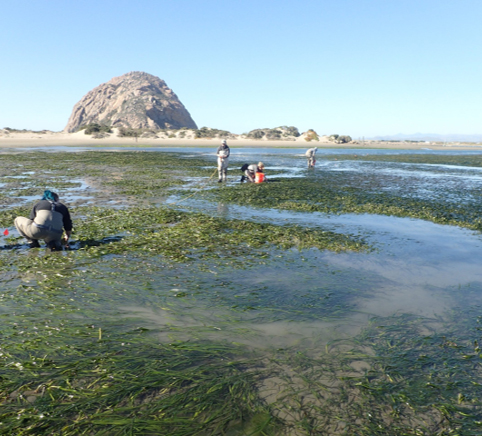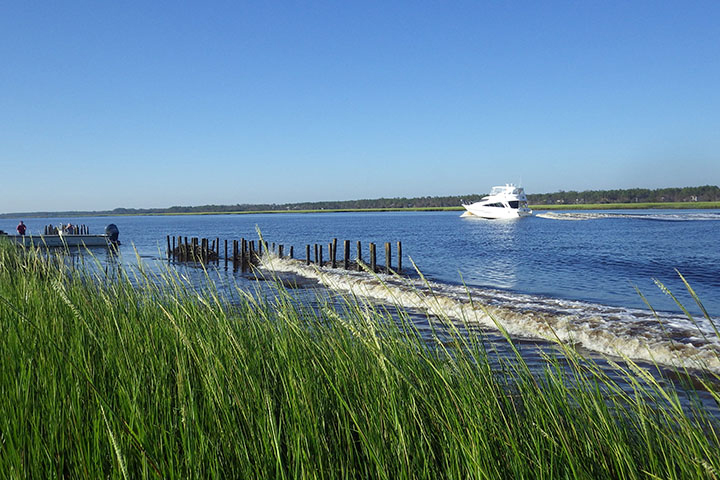NOAA’s “Green” Expertise Meets New Infrastructure Era
The Takeaway: Some U.S. infrastructure funding that is headed NOAA’s way will maximize the benefits of nature to lessen climate change damage.
The U.S. Infrastructure Investment and Jobs Act, recently passed by Congress and signed into law by President Biden, contains $2.96 billion over five years in future NOAA investments to advance “climate smart, climate ready, and climate resilient” infrastructure, in the words of NOAA Administrator Dr. Rick Spinrad. The agency’s natural (or “green”) infrastructure projects will play an important part, using plantings, soils, and other ecological materials to filter, absorb, and redirect excess water.
The increased infrastructure funding below will lead to more natural infrastructure investments for several NOAA programs over five years.
- $207 million will support habitat restoration projects through the National Coastal Zone Management Program.
- $77 million will support restoration projects in the National Estuarine Research Reserve System (representing a 54 percent increase per year). Many future efforts will advance natural infrastructure research through the research reserves’ Science Collaborative, which is jointly administered by NOAA and the University of Michigan.
- $492 million will support National Coastal Resilience Fund grants, which NOAA implements in partnership with the National Fish and Wildlife Foundation.
NOAA has spent decades maximizing the resilience benefits of mangroves, oyster reefs, wetlands, dunes, and more, and for good reason. U.S. coastal wetlands alone provide an estimated $23.2 billion in storm protection services each year. Projects featured below highlight natural infrastructure’s many advantages for coastal communities.
Floodwaters shrink, amenities grow

Photo credit: NOAA
Texas. When fierce coastal storms sweep into the community of Clear Lake, a lush urban wetland (reclaimed from an abandoned golf course) acts like a sponge to keep floodwaters away from area homes. Exploration Green’s five detention lakes store 500 million gallons of water, and its green space includes 40 acres of wetlands plus athletic fields, parkland, and miles of trails.
This vast water-storage capacity saves homes nearby from flood damage—but what really gets the community excited are the many birds flocking to restored native landscaping, and the hiking and biking paths. “Not only did my house not flood,” says one homeowner, “I am getting my husband to exercise now, thanks to Exploration Green.”
The project received support from the Texas General Land Office’s Coastal Management Program through a grant from NOAA’s Office for Coastal Management. Other support came from water district bonds, local and state grants, donations, technical assistance, and volunteers.
Dunes, buffers, and berms halt erosion

Photo credit: Morro Bay National Estuary Program
Washington State. The Shoalwater Bay Tribe helped to lead partner buy-in on a pilot project that virtually stopped areas of shoreline erosion in its tracks. Along Willapa Bay, the partners rebuilt dunes, restored natural buffers, and lined shoreline areas with cobble berms, which combine beach sand with stones and mid-sized rocks. The berms move with the waves but take much energy out of them. The added features even helped the beach accumulate extra sand in some spots, great news in an area where coastal land loss has averaged as much as 100 feet per year.
The partners are seeking more funding to expand these results. Doing so could save much tribal habitat for subsistence shellfish growing; preserve cranberry crops that represent more than half of all state growers; safeguard local businesses near the shoreline; and secure the fastest local route for emergency responders.
The Washington Coastal Zone Management Program provided technical and monitoring assistance and worked to secure grants, one supported by NOAA’s Office for Coastal Management. Pacific County, the North Cove community, and the Shoalwater Bay Tribe formed the Willapa Erosion Control Alliance Now to bring together many partners.
Mix of techniques tames wild waves

Photo credit: NOAA
Florida. No one infrastructure approach will work for every area. In fact, some projects get the best results by combining natural infrastructure with harder, processed materials. Along a shoreline that was buffeted by fierce wave action and boat wakes, just such a dual-defense strategy led to a 30 to 90 percent reduction in destructive wave energy. Porous wooden breakwalls were placed in front of structures that attract thousands of oysters, which act as a natural barrier to waves.
Already, this project has inspired similar installations in other Florida estuaries. Joining in this multi-partner project were the Guana Tolomato Matanzas Research Reserve, NOAA’s Science Collaborative program, and St. Johns River Water Management District.
To learn more about the benefits of natural infrastructure and NOAA’s work, view these fast facts. (2022)
Partners: Chesapeake Stormwater Network; Clear Lake City Water Authority; Exploration Green Conservancy; Florida’s Aquatic Preserves; Florida Department of Environmental Protection; Friends of the Guana Tolomato Matanzas Reserve; Friends of North Cove; Galveston Bay Foundation; Grayland Drainage District 1; Marine Resources Research Institute; Mott MacDonald; New Hampshire Department of Environmental Services; NOAA’s ACE Basin, Great Bay, Guana Tolomato Matanzas, Narragansett Bay, North Inlet-Winyah Bay, Waquoit Bay, and Wells National Estuarine Research Reserves; NOAA Office for Coastal Management; NOAA Science Collaborative; North Willapa Harbor Grange 947; Ocean Spray Cranberry Growers; Oregon State University; Pacific Conservation District; Pacific County; Radboud Universteit Nijmegan; Roca Communications; Royal Netherlands Institute for Sea Research; Shoalwater Bay Tribe; South Carolina Department of Health and Environmental Control’s Office of Ocean and Coastal Resource Management; South Carolina Department of Natural Resources’ Office of Fisheries Management; Texas Coastal Management Program of the Texas General Land Office; U.S. Army Corps of Engineers; U.S. Environmental Protection Agency; U.S. Fish and Wildlife Service; University of Florida’s Engineering School of Sustainable Infrastructure and Environment; University of New Hampshire Stormwater Center; Washington State Department of Archaeology and Historic Preservation, Department of Ecology’s Coastal Zone Management Program, Department of Fish and Wildlife, Department of Natural Resources, Department of Transportation, Emergency Management Division, Office of the Governor’s Coastal Marine Advisory Council, and Parks and Recreation Commission; and Washington Sea Grant.
PRINT